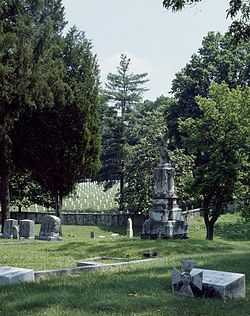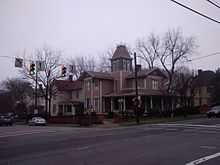Historic Oakwood
|
Oakwood Historic District | |
 | |
|
Oakwood Confederate Cemetery | |
| Location | Roughly bounded by N. Boundary, Person, Jones, and Linden Sts., and Oakwood Cemetery, Raleigh, North Carolina |
|---|---|
| Area | 190 acres (77 ha) |
| Architectural style | Second Empire, Queen Anne, Classical Revival |
| Governing body | Private |
| NRHP Reference # |
74001380[1] (original) 87001787 (increase 1) 87002235 (increase 2) 88003044 (increase 3) |
| Significant dates | |
| Added to NRHP | June 25, 1974 |
| Boundary increases |
October 21, 1987 January 6, 1988 January 9, 1989 |

Historic Oakwood is a neighborhood in downtown Raleigh, North Carolina, United States, on the National Register of Historic Places, and known for its Historic Oakwood Cemetery, its many Victorian houses and its location close to the Mordecai Plantation Manor. Located near the Governor's Mansion and the State Capitol, during the 19th century Historic Oakwood was home to prominent members of Raleigh's society. It is Raleigh's earliest white middle-class suburb, and unlike later suburbs, it developed lot-by-lot over time, instead of by platted sections. Its Victorian-era architectural styles include Second Empire, Queen Anne, and Italianate. Later infill brought the bungalow, the foursquare, Craftsman style, and the Minimal Traditional house to the area.
Oakwood is also known for its Christmas Candlelight Tour, which opens private historic residences to the public, and the Garden Tour, which allows the public to see the vast gardens worked on by the Oakwood Gardening Club.[2]
Oakwood was listed on the National Register of Historic Places in 1974 and is also one of six local historic overlay districts (HOD). Several Oakwood residences are also individually recognized as Local Historic Landmarks.
History
Oakwood is the only intact nineteenth century neighborhood in Raleigh, North Carolina. The neighborhood was built in the dense woods of Northeast Raleigh known as “Mordecai Grove” and sold off in parcels after the American Civil War to individuals and developers such as Col. J. M. Heck, Richard Stanhope Pullen, W. C. and A. B. Stronach, and Thomas H. Briggs. The great variety of Victorian architectural styles represented in the neighborhood reflects the middle-class tastes of the business and political leaders of Raleigh for whom they were built, as well as the skill of local architects and builders.
Following World War I, as the automobile came into general use and fashionable neighborhoods developed in Raleigh's outskirts, second generation Oakwood residents moved away. Many of the large residences became boarding or apartment houses. This depressed economic state preserved the houses from destructive modernization, but not from deterioration. By 1970, the area appeared destined for urban renewal. In 1970 and 1971, however, the rehabilitation of several houses sparked a general neighborhood revitalization. The announcement in 1972 of a major thoroughfare through the heart of the neighborhood united residents who formed the non-profit corporation the Society for the Preservation of Historic Oakwood. The thoroughfare plan was thwarted and the neighborhood revitalization continues.
As you walk through the neighborhood, you can notice the trends in architecture reflecting individual tastes throughout the years as well as features common to most houses built in this Southern climate. About the time of the Civil War, the Neo-Classical style of architecture was popular. This style was patterned after the ancient Greek temples with their large heavy columns topped with ornate capitals. The 70's saw a trend to a style “imported” from France, the Second Empire, a pompous style typified by Mansard roofs. Coming into the 80's and 90's the Victorians looked to England for a new type of architecture, the Queen Anne style. Queen Anne architecture sought to delight the eye with contrasting elevations, uses of texture and color, and free “romantic” forms. After the Chicago Exhibition of 1893, architecture saw a return to the historic styles of the Greeks and Romans in the Neo-Classical Revival style. The architects were once again striving for correctness of form and symmetry.
Although most of the homes in Oakwood reflect individual tastes and differences in architecture, there are many common denominators. The architectural styles were modified for a Southern climate. Better than ninety percent of the houses have at least one porch. The roofs have a deep pitch in order to form large attics for added insulation. Latticework appears on rear service porches and under the houses to maintain circulation of air on warm summer days.
There are, other interesting features to watch for in a walk through the neighborhood. Low walls, sometimes of granite, on the property lines of many houses were used to demarcate the property Some of the homes still retain the blue porch ceilings to resemble the sky and, according to Southern folklore, to scare flies away. The transoms and sidelights seen often on the homes, were methods of lighting the hallways before electricity. Decorative and unusual vents in the attics were also a reflection of the individual tastes of Victorian homeowners.
Oakwood is now one of Raleigh's tourist attractions. In recognition of Oakwood's importance as a valuable tangible reminder of Southern urban life during the 19th and 20th centuries, the neighborhood has been listed as a historic district in the National Register of Historic Places.
The City of Raleigh designated Oakwood as its first local historic district in 1974 to ensure that the physical charm and special character of the neighborhood is maintained. As part of the local historic district designation, all exterior changes are subject to design review by the Raleigh Historic Districts Commission.
See also
- Historic Oakwood Cemetery
- National Register of Historic Places listings in Wake County, North Carolina
- Mordecai House
- St. Mark's Chapel (Raleigh, North Carolina)
References
- ↑ "National Register Information System". National Register of Historic Places. National Park Service. 2010-07-09.
- ↑ "Welcome". The Society for the Preservation of Historic Oakwood.
- ↑ Raleigh Historic Districts Commission-Oakwood
- ↑ National Register of Historic Places Nomination Form